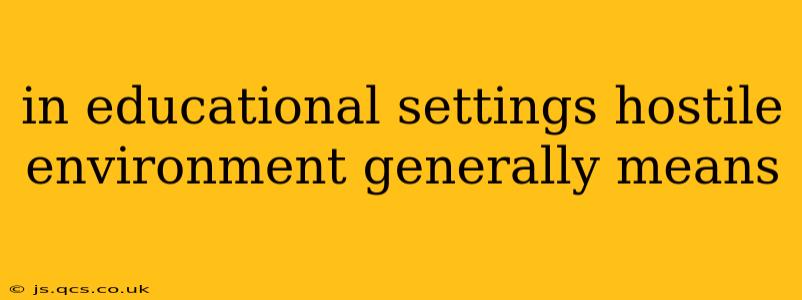A hostile environment in an educational setting refers to any situation where a student or staff member experiences unwelcome conduct based on their protected characteristics. This conduct is so severe, persistent, or pervasive that it creates an intimidating, threatening, or abusive educational environment. It significantly interferes with a person's ability to learn, work, or participate fully in the educational community. This differs significantly from isolated incidents; the key is the cumulative effect of the behavior.
What are examples of a hostile environment in a school?
Examples of behaviors that can contribute to creating a hostile environment include, but aren't limited to:
-
Harassment: This can take many forms, including verbal harassment (slurs, insults, threats), physical harassment (assault, battery, unwanted touching), and visual harassment (offensive images, gestures). It often targets individuals based on race, color, national origin, sex (including sexual harassment), religion, age, disability, sexual orientation, gender identity, or other protected characteristics.
-
Bullying: Persistent and aggressive behavior intended to intimidate, humiliate, or harm another person. This can be physical, verbal, or psychological and often involves a power imbalance. Cyberbullying, using electronic devices to harass or intimidate, is also a significant concern.
-
Discrimination: Unequal treatment based on a protected characteristic, resulting in exclusion, denial of opportunities, or other adverse impacts. This could involve biased grading, unequal access to resources or programs, or unfair disciplinary actions.
-
Threats of violence: Any communication that suggests a credible intention to harm or injure another person. This can include direct threats, implied threats, or even seemingly casual remarks that cause a reasonable fear of violence.
-
Sexual harassment: Unwelcome sexual advances, requests for sexual favors, and other verbal or physical conduct of a sexual nature that creates a hostile or abusive environment. This includes quid pro quo harassment (where submission to sexual conduct is made a condition of employment or education) and hostile environment harassment (where sexual conduct creates a hostile or abusive work or educational environment).
What constitutes "severe, persistent, or pervasive" behavior?
Determining whether behavior creates a hostile environment involves considering its severity, persistence, and pervasiveness. A single severe incident can be enough, but so can numerous less severe incidents that cumulatively create an intolerable atmosphere. For example:
-
Severity: A single act of serious violence or a graphically explicit sexual assault would likely be considered severe.
-
Persistence: Repeated, smaller instances of harassment, like constant name-calling or subtle exclusion, can accumulate to create a hostile environment.
-
Pervasiveness: Behavior that is widespread or affects multiple individuals within the school community might be deemed pervasive.
How is a hostile environment addressed in schools?
Schools have a legal and ethical obligation to address hostile environments. This typically involves:
-
Reporting mechanisms: Clear and accessible procedures for reporting incidents of harassment, bullying, and discrimination.
-
Investigations: Thorough and impartial investigations into reported incidents.
-
Disciplinary actions: Appropriate consequences for those found responsible for creating a hostile environment. This could range from warnings and counseling to suspension or expulsion.
-
Preventive measures: Programs and policies designed to prevent harassment, bullying, and discrimination, such as anti-bullying campaigns, diversity training, and bystander intervention programs. This also includes regular review and updating of policies to ensure they are current and effective.
How is a hostile environment different from other forms of misconduct?
A hostile environment differs from other forms of misconduct in its focus on the overall atmosphere created by the behavior. Isolated incidents of misbehavior might be addressed through other disciplinary processes, but a hostile environment involves a pattern of behavior that creates a climate of fear, intimidation, or abuse. It's about the impact and effect on the victim, their ability to participate fully in the educational setting.
Who is responsible for addressing a hostile environment in a school?
All members of the school community—administrators, teachers, staff, students—share a responsibility for creating and maintaining a safe and welcoming educational environment. Administrators have a particular responsibility to establish and enforce policies that prevent and address hostile environments. Teachers and staff have a role in reporting incidents and intervening when they witness inappropriate behavior. Students also have a responsibility to treat each other with respect and report incidents of harassment or bullying.
